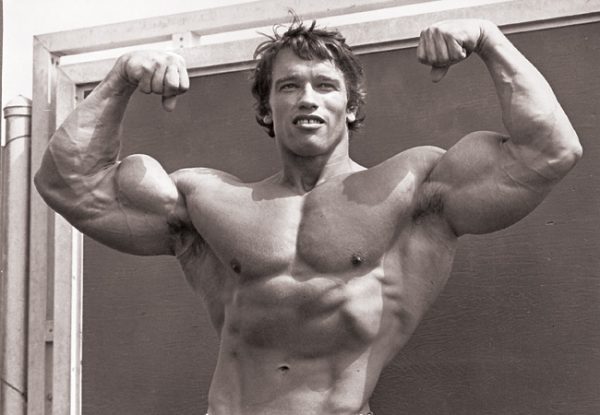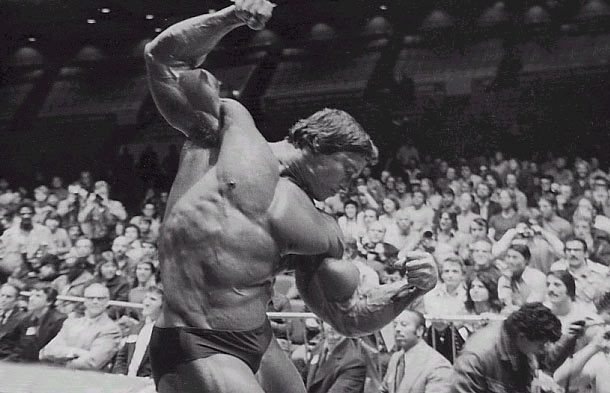Big Arms: How to Get Arms Like Arnold Schwarzenegger

Arnold Schwarzenegger had massive arms, 22 inches big at his peak. In his book The New Encyclopedia of Modern Bodybuilding, he explains how you, too, can get big arms.

One of his secrets is to train them “by themselves when you are rested and strong” or “on leg days when your arms are rested.” A great way to do this is with a specialization routine.
Arnold himself used specialization routines, and they’ve been around forever. But now, even exercise scientists recommend them. Leading hypertrophy researcher Brad Schoenfeld PhD did exactly that in a podcast interview. For specialization routines, he suggested “prioritizing the muscle group in the sequence and increasing the volume” (Schoenfeld, 2018).
But he also cautioned: “In some cases, pulling back volume might be needed if the muscle is being overtrained” (Schoenfeld, 2018). In my experience, that’s a common mistake with specialization routines. Heck, I made it.
When I started out at 16, I wasn’t happy with my chest. So, I devised a monster chest workout. Half my daily volume would go just to chest. It worked at first (I grew), but I quickly plateaued. Looking back, I was probably overtraining my chest.
An arm specialization routine speeds up your gains because it gives your arms a stronger training stimulus while you run it. It lets you increase your volume and load for that body part, both of which are important to progress your training for size. But you must not overdo it.
What I recommend now to guys who want big arms is to add volume to their arm training gradually. I also recommending training them by themselves when you are rested and strong (like Arnold advised), or if you can’t, on other training days—at the beginning of your workout (like Brad Schoenfeld recommends).
Summary of Recommendations for Specialization Routines to Get Big Arms
- Add volume to your arm training gradually
- Train them by themselves when you are rested and strong (best)
- Train them on other training days at the beginning of your workout (second best)
Start with 2 exercises for your biceps and 2 for your triceps. If you’re lacking in forearm development, you can also add 2 for your forearms (it’s optional). A sample program might look like this (I’ve included exercises with peak tension at different points of the contraction, to maximize regional muscle hypertrophy).
- Cable Curl (With Rope)
- Skullcrusher
- Supine Dumbbell Curl
- Seated Triceps Extension
Notice biceps and triceps alternate, leaving you more time to recover between exercises for the same muscle group. This lets you lift heavier weights, speeding up your overall progression (progressive overload is the key to getting stronger and bigger over time).
Start with 2 sets per exercise, and work up to a maximum of 5 sets. Keep reps between 6 and 20, undulating to speed up your gains. Take all sets close to failure (keep 1-2 reps in the tank).
Adapt These Arms Guidelines to You
There you have it: the basics of a sound specialization routine to get big arms. To get maximum results, you’ll need to adapt these guidelines to you, as your body likely responds in its own unique way (for me, over time, I’ve found I generally respond best to volume in the lower end of the range—I overtrain easily).
Finding what works best for you can take years. To speed that up, you can hire a good coach (Andy Morgan and Steve Hall are good, and they charge $300-$500 a month last time I checked). If that’s outside your budget, our app Dr. Muscle can do the trick.
It uses AI to guide you when you work out, applying all the guidelines I wrote above automatically. And now, for the first time ever, it also include specialization routines. The exact arms routine I’ve outlined above is in beta inside the app, and glutes and abs are coming up next (we’re looking for testers—if you’re already using the app and want to grow your arms, email us).
In short, Dr. Muscle is like a trainer in your phone, but 10 times cheaper, 59% faster (thanks to rest-pause sets), evidence-based, and always up to date. Get your invitation if you’d like to give it a shot.
